Six year study proves wireless kills trees?
Health Freedom Idaho Toxins August 02, 2017
Wireless Kills Trees. A six-year study of trees around wireless cell towers reveals the ‘invisible’ damage of exposure to RF radiation. Radiation from wireless technology is now jeopardizing the health of our trees and other plants. “Tree damage in the vicinity of mobile phone base stations” by Waldmann-Selsam and Egar in 2013, documented suspected RF radiation related tree damage and RF radiation readings over a period of six years.
It found significantly higher RF radiation readings by damaged trees as compared to undamaged trees. Sometimes damaged areas and undamaged areas were on the same tree, in which case RF radiation levels were found to be higher near the damaged areas. Because trees are unable to move, differences in RF radiation levels from fixed sources like cell towers can result in very different RF radiation exposure micro-environments in different parts of the same tree or bush.
Researchers state “More recently, it has been shown that mortality rates of all dominant tree species in the western United States have been doubling every 17-29 years in old growth forests, and that recruitment of new trees is now occurring at a lower rate than mortality.” The aspen experiment combined with other measurement and observational studies make a compelling case that our addiction to wireless technology is killing the trees we need so much for life far faster than they can replace themselves.
In the Netherlands, because of the increased use if Wi-Fi over the last few years, a whopping 70% of urban trees are suffering from radiation poisoning, up from only 10% five years ago.
Most people don’t really stop to consider how their cell phone or other wireless devices work. They’re just “magic” and “neat” and “convenient.” If they do think about it, common perception includes these erroneous assumptions: direct communication from device to base station similar to an invisible wire or a homogeneous RF field put out by devices and towers.
Neither of these are true.
The RF fields put out by both devices and towers are not exclusively direct from device to tower. Nor are the RF fields homogeneous. There are areas of high RF concentration immediately adjacent to areas that are much lower. The exact nature of the fields depends on the transmitter configuration and use at the time. Hence, when you make a call on a cell phone or download a video on WiFi, the RF radiation (specifically, microwave radiation) used by the wireless devices goes through you and everyone around you. Which person, tree, or other creature is exposed to the most RF radiation will depend on the device, your surroundings, and the base station transmitter location. Trees cannot move when they start to “feel bad” and show signs of damage.
Tree give us oxygen and clear our air. Their health is declining visibly due to exposure.
What about the impact on human health?
These towers are being placed at schools, shopping malls, and near neighborhoods. The federal government has given cell phone companies exemption from all local ordinances as long as they can prove there is a gap in coverage. This means that even if NOBODY in the area wants it installed, they are still able to install it, and there is nothing we residents can do about it.
What about City, County and State Governments – will they listen to citizen concerns?
In Meridian and Eagle, Idaho, the West Ada school officials seemed to be unconcerned.
Could that be due to the fact that the district receives up to $2,500 a month for each cell tower site or as much as $180,000 a year. The proposed tower on an Eagle Elementary school in 2013 was opposed by the public. But in 2017 Eagle High school installed a cell tower after it was APPROVED by the school board in 2016. After being informed of the radiation testing results at the school, there has been no response or comment from the school board or the state governments.
Testing results from the Eagle High School property as reported by Lisa Doyon:
maps, results and detailed research can be found at EagleHealing,com
The radiation from cell phones, towers, WI-FI, cordless technology is all the same microwave energy just at different frequencies and levels. But the effects are the same. After the school board approved a cell tower at the local high school where my daughter attends, I rented a meter to see for myself if there was indeed radiation outside and/or inside the school. The results were shocking even to me. As much as 66,700% higher levels of radiation measured in classrooms facing the tower than what has been shown to cause biological effects on us.
And the measurements of the WI-FI/wireless devices in my house were not much better. It has caused me to make a plan to become WI-FI free in my house. It can be done even if you have laptops, tablets, and phones you want to use with the internet. It just takes a little inconvenience and a little money. But most all of us have unknowingly turned our homes into microwave ovens. The power level, though, is at a much lower level than your cooking microwave, so it’s just cooking you much slower, but is cooking you nevertheless. Click here to go right to the tower measurements. Click here to go right to the WI-FI/device measurements.
Halgamuge, M.N. “Weak radiofrequency radiation exposure from mobile phone radiation on plants.” Electromagnetic Biology and Medicine, vol. 36, no. 2, 2017, pp. 213-235.
- “Our analysis demonstrates that the data from a substantial amount of the studies on RF-EMFs from mobile phones show physiological and/or morphological effects (89.9%, p < 0.001). Additionally, our analysis of the results from these reported studies demonstrates that the maize, roselle, pea, fenugreek, duckweeds, tomato, onions and mungbean plants seem to be very sensitive to RF-EMFs. Our findings also suggest that plants seem to be more responsive to certain frequencies…”
Waldmann-Selsam, C., et al. “Radiofrequency radiation injures trees around mobile phone base stations.” Science of the Total Environment, vol. 572, 2016, pp. 554-69.
Gustavino, B., et al. “Exposure to 915 MHz radiation induces micronuclei in Vicia faba root tips.” Mutagenesis, vol. 31, no. 2, 2016, pp. 187-92.
- The increasing use of mobile phones and wireless networks raised a great debate about the real carcinogenic potential of radiofrequency-electromagnetic field (RF-EMF) exposure associated with these devices. Conflicting results are reported by the great majority of in vivo and in vitro studies on the capability of RF-EMF exposure to induce DNA damage and mutations in mammalian systems. Aimed at understanding whether less ambiguous responses to RF-EMF exposure might be evidenced in plant systems with respect to mammalian ones, in the present work the mutagenic effect of RF-EMF has been studied through the micronucleus (MN) test in secondary roots of Vicia faba seedlings exposed to mobile phone transmission in controlled conditions, inside a transverse electro magnetic (TEM) cell.
- Exposure of roots was carried out for 72h using a continuous wave (CW) of 915 MHz radiation at three values of equivalent plane wave power densities (23, 35 and 46W/m2). The specific absorption rate (SAR) was measured with a calorimetric method and the corresponding values were found to fall in the range of 0.4-1.5W/kg.
- Results of three independent experiments show the induction of a significant increase of MN frequency after exposure, ranging from a 2.3-fold increase above the sham value, at the lowest SAR level, up to a 7-fold increase at the highest SAR. These findings are in agreement with the limited number of data on cytogenetic effects detected in other plant systems exposed to mobile phone RF-EMF frequencies and clearly show the capability of radiofrequency exposure to induce DNA damage in this eukaryotic cell system.
- It is worth noticing that this range of SAR values is well below the international limits for localised exposure (head, trunk), according to the ICNIRP guidelines (35) and IEEE std C95.1 (38), which are 10 (8.0) W/kg for occupational exposure and 2.0 (1.6) W/kg for general public exposure respectively.
Halgamuge, Malka N., See Kye Yak and Jacob L. Eberhardt. “Reduced growth of soybean seedlings after exposure to weak microwave radiation from GSM 900 mobile phone and base station.” Bioelectromagnetics, vol. 36, no. 2, 2015, pp. 87-95.
- The aim of this work was to study possible effects of environmental radiation pollution on plants. The association between cellular telephone (short duration, higher amplitude) and base station (long duration, very low amplitude) radiation exposure and the growth rate of soybean (Glycine max) seedlings was investigated.
- The exposure to higher amplitude (41 V m−1) GSM radiation resulted in diminished outgrowth of the epicotyl. The exposure to lower amplitude (5.7 V m−1) GSM radiation did not influence outgrowth of epicotyl, hypocotyls, or roots. The exposure to higher amplitude CW radiation resulted in reduced outgrowth of the roots whereas lower CW exposure resulted in a reduced outgrowth of the hypocotyl. Soybean seedlings were also exposed for 5 days to an extremely low level of radiation (GSM 900 MHz, 0.56 V m−1) and outgrowth was studied 2 days later. Growth of epicotyl and hypocotyl was found to be reduced, whereas the outgrowth of roots was stimulated.
- Our findings indicate that the observed effects were significantly dependent on field strength as well as amplitude modulation of the applied field.
Senavirathna, M.D., et al. “Nanometer-scale elongation rate fluctuations in the Myriophyllum aquaticum (Parrot feather) stem were altered by radio-frequency electromagnetic radiation.” Plant Signal Behav, vol. 9, no. 3, 2014.
- Statistically significant changes to this plant from a non thermal effect.
Soran, M.L., et al. “Influence of microwave frequency electromagnetic radiation on terpene emission and content in aromatic plants.” Journal of Plant Physiology, vol. 171, no. 15, 2014, pp. 1436-43.
- Microwave irradiation resulted in thinner cell walls, smaller chloroplasts and mitochondria, and enhanced emissions of volatile compounds, in particular, monoterpenes and green leaf volatiles (GLV). These data collectively demonstrate that human-generated microwave pollution can potentially constitute a stress to the plants.
- The above is only a small sampling of the research showing biological effects at non thermal levels on living organisms.
Haggerty, Katie. “Adverse Influence of Radio Frequency Background on Trembling Aspen Seedlings.” International Journal of Forestry Research, vol 2010, no. 836278, 2010.
- “This study suggests that the RF background may have strong adverse effects on growth rate and fall anthocyanin production in aspen, and may be an underlying factor in aspen decline.”
Read more at our webpage on peer reviewed science on the environment https://ehtrust.org/science/bees-butterflies-wildlife-research-electromagnetic-fields-environment/
This article originally appeared at: https://ehtrust.org/tree-damage-caused-mobile-phone-base-stations-observation-guide-helmut-breunig/.
RESOURCE:
Photos and RF measurements by Cornelia Waldmann-Selsam Additional photos by Alfonso Balmori, Helmut Breunig, Örjan Hallberg, Volker Schorpp and Monika Schuberth-Brehm
This documentation can be found online at Kompetenzinitiative.net. We have posted the peer-reviewed research that shows that cell tower mobile phone base station radiation damages trees below this document.
Note the published article by Waldmann-Selsam, C., et al. “Radiofrequency radiation injures trees around mobile phone base stations.” Science of the Total Environment, vol. 572, 2016, pp. 554-69.
2017_Observation_Guide_ENG_FINAL_RED
Radiofrequency radiation injures trees around mobile phone base stations
Aug 2016
In the last two decades, the deployment of phone masts around the world has taken place and, for many years, there has been a discussion in the scientific community about the possible environmental impact from mobile phone base stations. Trees have several advantages over animals as experimental subjects and the aim of this study was to verify whether there is a connection between unusual (generally unilateral) tree damage and radiofrequency exposure. To achieve this, a detailed long-term (2006-2015) field monitoring study was performed in the cities of Bamberg and Hallstadt (Germany). During monitoring, observations and photographic recordings of unusual or unexplainable tree damage were taken, alongside the measurement of electromagnetic radiation. In 2015 measurements of RF-EMF (Radiofrequency Electromagnetic Fields) were carried out. A polygon spanning both cities was chosen as the study site, where 144 measurements of the radiofrequency of electromagnetic fields were taken at a height of 1.5m in streets and parks at different locations. By interpolation of the 144 measurement points, we were able to compile an electromagnetic map of the power flux density in Bamberg and Hallstadt. We selected 60 damaged trees, in addition to 30 randomly selected trees and 30 trees in low radiation areas (n=120) in this polygon. The measurements of all trees revealed significant differences between the damaged side facing a phone mast and the opposite side, as well as differences between the exposed side of damaged trees and all other groups of trees in both sides. Thus, we found that side differences in measured values of power flux density corresponded to side differences in damage. The 30 selected trees in low radiation areas (no visual contact to any phone mast and power flux density under 50μW/m(2)) showed no damage. Statistical analysis demonstrated that electromagnetic radiation from mobile phone masts is harmful for trees. These results are consistent with the fact that damage afflicted on trees by mobile phone towers usually start on one side, extending to the whole tree over time.
http://kompetenzinitiative.net/KIT/KIT/baeume-in-bamberg/
https://groups.google.com/forum/#!topic/mobilfunk_newsletter/5r37cJ-EqPI
source
https://www.researchgate.net/publication/306435017_Radiofrequency_radiation_injures_trees_around_mobile_phone_base_stations
High-frequency transmitters cause Tree Damage
A live recording of the lecture from 02.06.2007
in St. Peter in the Black Fores
http://www.puls-schlag.org/download/Schorpp-StPeter-20070929-online200dpi.pdf
ENGLISH : https://emrabc.ca/wp-content/uploads/2019/08/TreesEMRTreesSchorpp-2011-02-18.pdf
BioMed Research International Volume 2016, Article ID 1830262, 13 pages http://dx.doi.org/10.1155/2016/1830262
Plant Responses to High Frequency Electromagnetic Fields
1Université d’Angers, Campus du Végétal, UMR 1345 IRHS, CS 60057, SFR 4207 QUASAV, 49071 Beaucouzé Cedex, France
2Department of Plant and Microbial Biology, North Carolina State University, P.O. Box 7612, Raleigh, NC 27695, USA
3Université Blaise Pascal, 24 avenue des Landais, 63177 Aubière Cedex, France
4Institut Pascal, Université Blaise Pascal, BP 10448, 63000 Clermont-Ferrand, France
5CNRS, UMR 6602, 63171 Aubière, France
Received 25 November 2015; Accepted 17 January 2016
Academic Editor: Yan-Bo Hu
Copyright © 2016 Alain Vian et al. This is an open access article distributed under the Creative Commons Attribution License, which permits unrestricted use, distribution, and reproduction in any medium, provided the original work is properly cited.
Abstract
High frequency nonionizing electromagnetic fields (HF-EMF) that are increasingly present in the environment constitute a genuine environmental stimulus able to evoke specific responses in plants that share many similarities with those observed after a stressful treatment. Plants constitute an outstanding model to study such interactions since their architecture (high surface area to volume ratio) optimizes their interaction with the environment. In the present review, after identifying the main exposure devices (transverse and gigahertz electromagnetic cells, wave guide, and mode stirred reverberating chamber) and general physics laws that govern EMF interactions with plants, we illustrate some of the observed responses after exposure to HF-EMF at the cellular, molecular, and whole plant scale.
Indeed, numerous metabolic activities (reactive oxygen species metabolism, α– and β-amylase, Krebs cycle, pentose phosphate pathway, chlorophyll content, terpene emission, etc.) are modified, gene expression altered (calmodulin, calcium-dependent protein kinase, and proteinase inhibitor), and growth reduced (stem elongation and dry weight) after low power (i.e., nonthermal) HF-EMF exposure. These changes occur not only in the tissues directly exposed but also systemically in distant tissues. While the long-term impact of these metabolic changes remains largely unknown, we propose to consider nonionizing HF-EMF radiation as a noninjurious, genuine environmental factor that readily evokes changes in plant metabolism.
The Effect of the built and natural environment on millimetric radio waves
For Department of Digital, Culture, Media and Sport February 2018
Final Report
FIFTH GENERATION MOBILE COMMUNICATIONS
6.5 Vegetationloss
Traditionally loss from vegetation has been concerned with large trees which can cause substantial loss to satellite communications. Their effect at frequencies above 6GHz has been studied in detail. Further measurements have also been carried out in the terrestrial case at high frequencies to account for the loss through trees with varying levels of foliage. For small cells, many streets and open areas will have small items of vegetation such as hanging baskets and street plants and hence measurements were carried out on samples illustrated in Figure 6-9 to compare plants with and without different foliage.

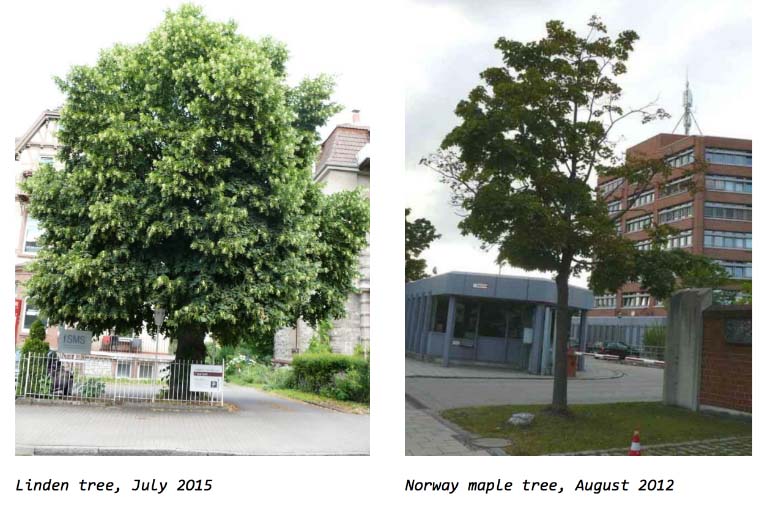
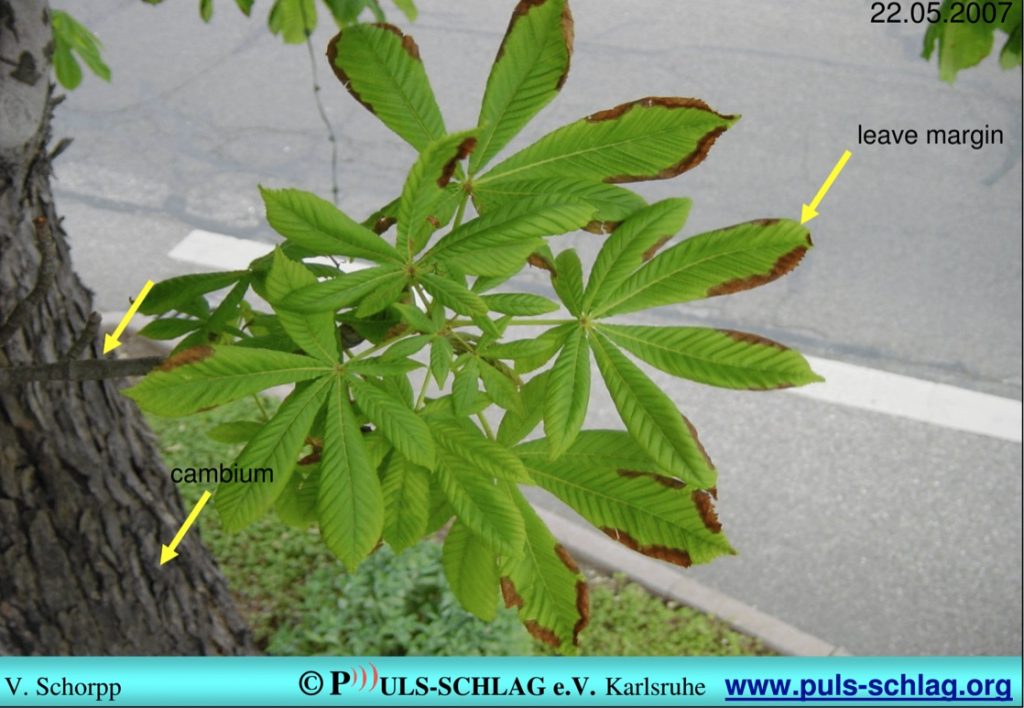
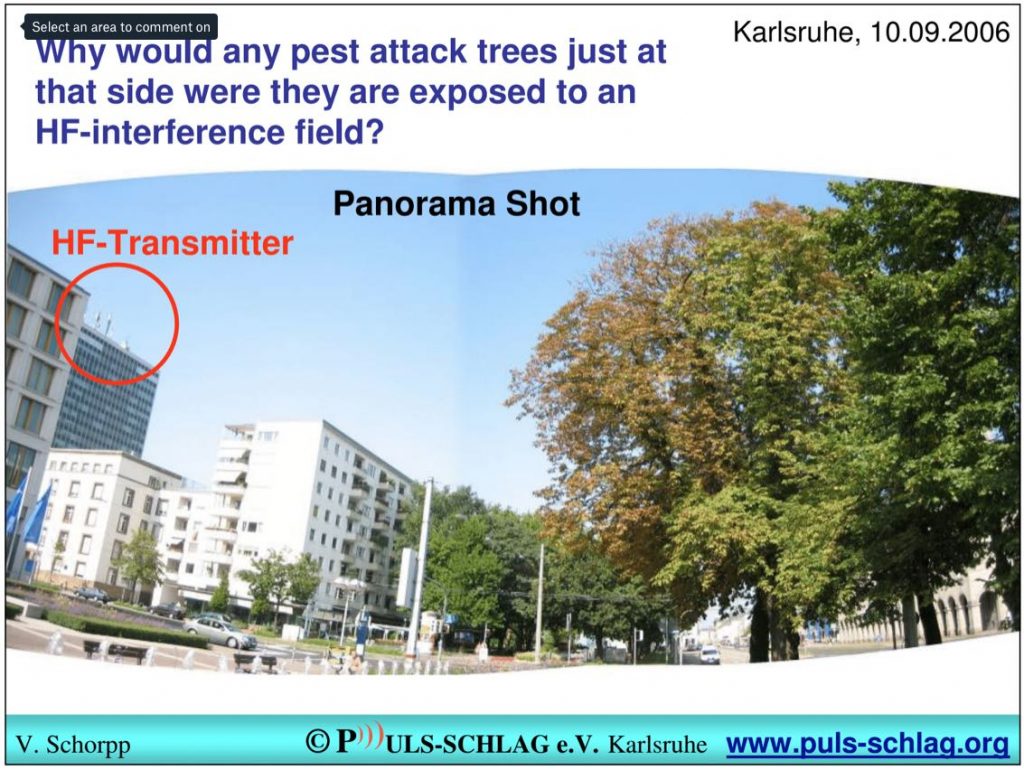
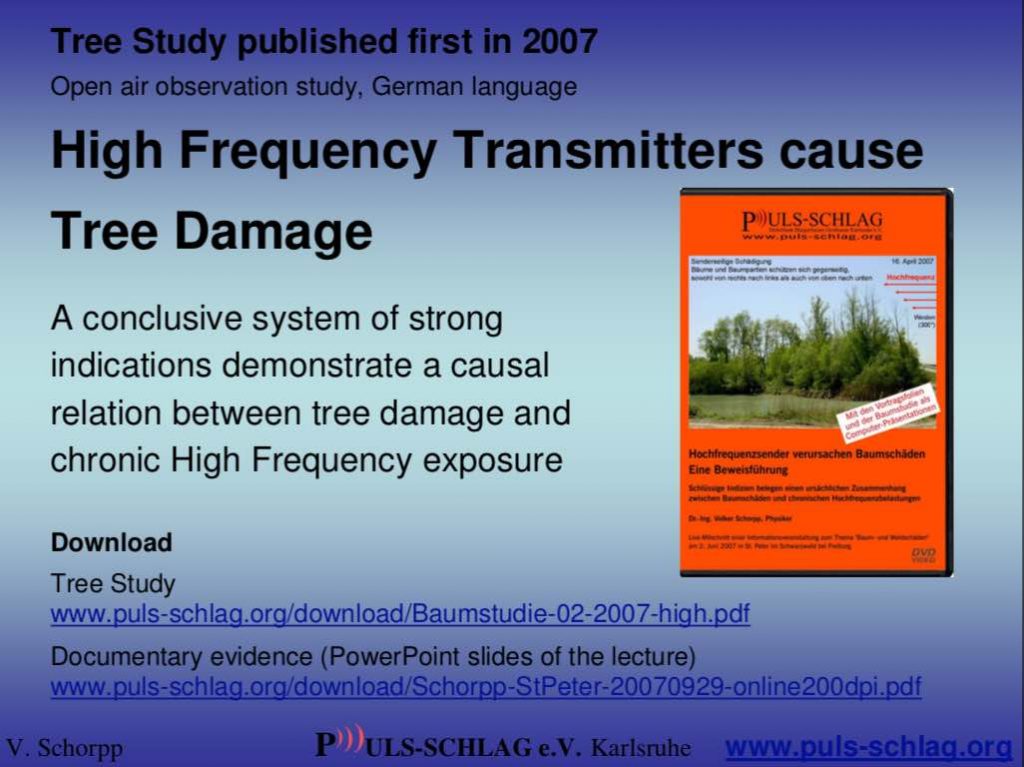
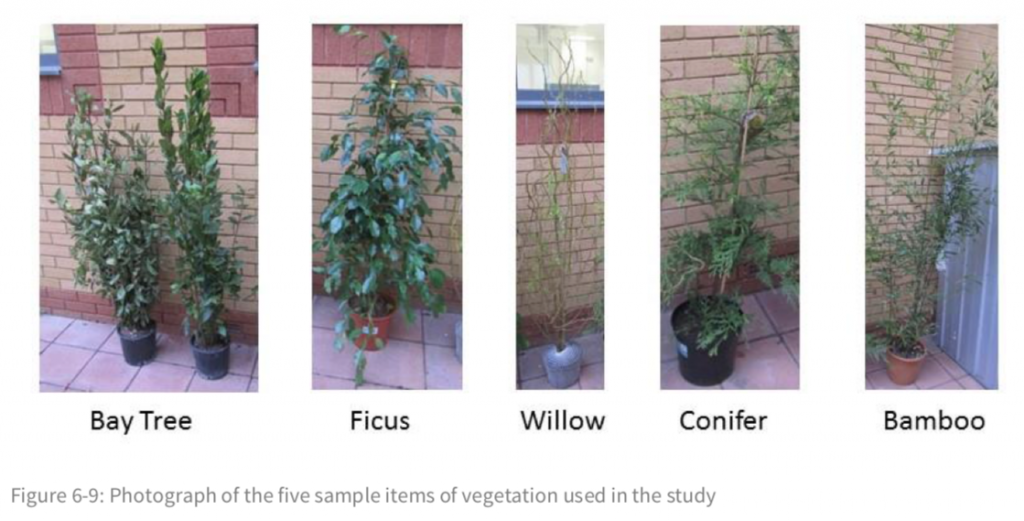
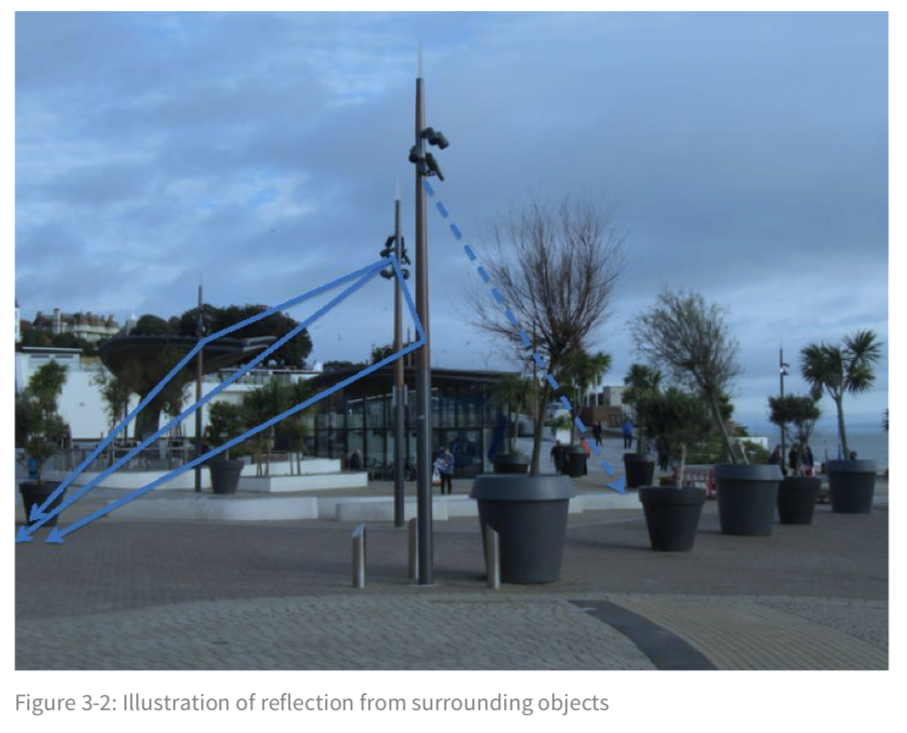
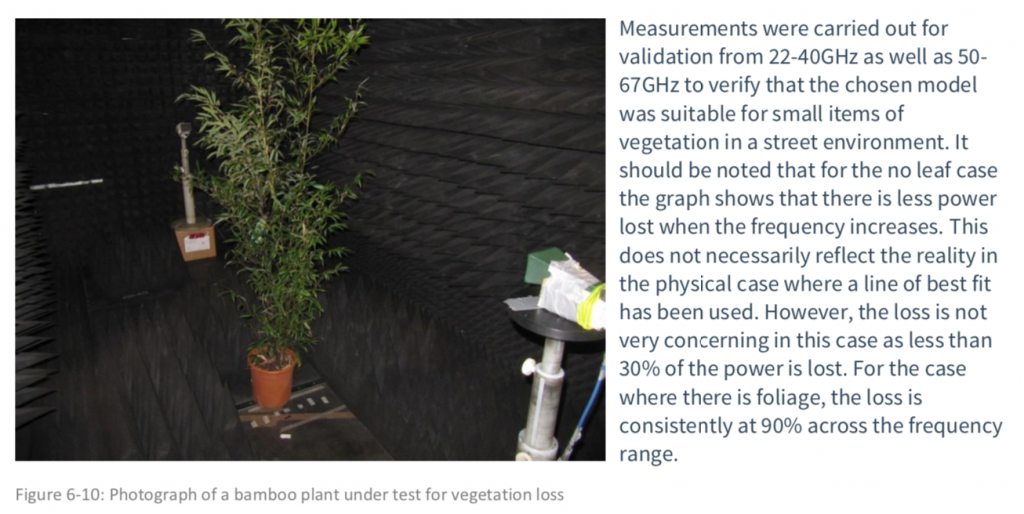
#1 by ted archibald on August 22, 2019 - 12:14 pm
Quote
It seems conclusive that RFR does cause harm to trees and I expect other plants.
So, it is reasonable to believe that RFR ALSO causes harm to other living things like animals and PEOPLE.
Then why are we still fighting the FCC and the Canadian ISED to understand this and prevent further harm.
The reason, IMHO, is that there is so much MONEY at stake in any decision that the ETHICS of HARM to the population is not an issue. Of course some would argue that the US Military has a big hand in this issue.
#2 by daniel on March 9, 2021 - 10:58 pm
Quote
people who don’t think 5G is dangerous need to really look at the environment around the masts if there are plants n trees you might notice some are dead in patches.
My local area i noticed patches today and that’s why i’m here.